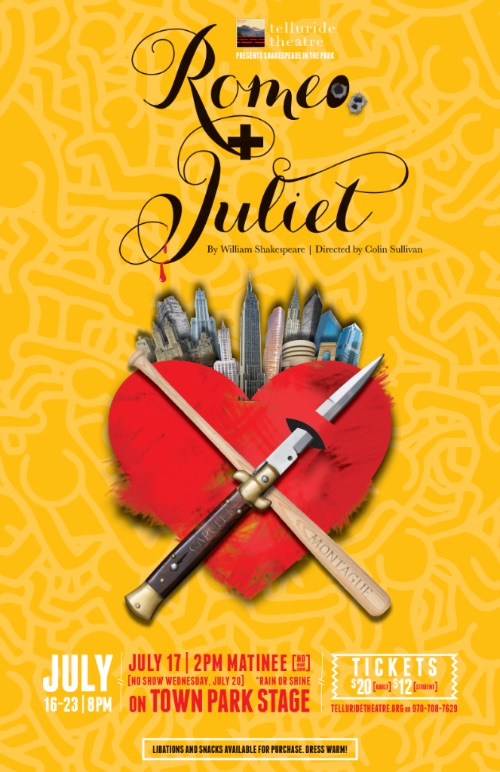
08 Jul Telluride Theatre: “Romeo & Juliet”
Telluride Theatre’s Shakespeare in the Park is “Romeo & Juliet.” The action takes place on the Town Park Stage, rain or shine. The production is directed Colin Sullivan and stars Caroline Grace Moore as Romeo and Chambri Swartz as Juliet. “Romeo and Juliet” runs from Saturday, July 16 (Locals’ Night) through Saturday, July 23, 8 p.m. (No show July 20). Tickets are $20 for adults; $12 for students here. Or here. Or call, 970-708-7629. (Suitable for ages 12+.)

It is the much-venerated “star-cross’d lovers” saga and the most performed of all Shakespeare’s plays, so finding a fresh vision for “Romeo & Juliet” is a daunting challenge.
Directors have set the play in courtyards, on colleges campuses, in black box theatres, on Broadway, and time and again on the silver screen.
Franco Zeffirelli’s 1968 version turns Mercutio into an aggressive homosexual.
Stephen Sondheim’s first Broadway success was “West Side Story.” (He wrote the lyrics to music by Leonard Bernstein.) Remember the book? Two street gangs, the Sharks and the Jets (Montagues and Capulets) rumbled to the death with switchblades on the streets of New York’s Hell’s Kitchen.
In the 1990s, director Baz Luhrmann picked up where Sondheim left off, but relocated the gangs to the Left Coast to a fictional Verona Beach, where guns blazed and Harleys roared. Bulls in heat.
There was a hip-hop adaptation done by an all-black cast: “Romeo & Juliet: Tribal.”
In the late-1990s, an off-Broadway troupe staged a production in which four men played all the parts to perfection. (Yes, I saw the show.)
Fast forward to this millennium, there was a version of the story featuring – wait for it –two garden gnomes (he being Gnomeo); another starring a zombie named “R” and girl named Julie; Orlando Bloom (Legolas from “Lord of the Rings”) opposite Condola Rashad billed as “a return to Broadway after 36 years.”
The endless twists and turns like a mountain road.
So for Telluride Theater’s executive director, actor-director Colin Sullivan to cast the lovers as two women is not a stretch. And especially not shocking at a time when the gender-sexuality spectrum runs the gamut through 50 shades of gray (and beyond the bedroom into public bathrooms).
But Colin’s casting, particularly of Romeo, is more than a simple, oh so hip riff on the Shakespearian tradition of having men and boys play all the characters. Because Colin looked hard at Shakespeare words to see into the heart of his characters, especially Romeo. And for Colin, the Bard’s Romeo embodies both the masculine and the feminine.
“Juliet had to be played by a woman. She is all girl,” explains Colin. “Romeo, however, could go either way: he is a lover and a killer; yin and yang. He as she represents the universal and fluid nature of love.”
What’s more, despite the many translations and popularizations of the work, not surprisingly, the ever resourceful and original Colin does manage to find a fresh setting, one that is particularly resonant today because it underlines what was a burgeoning conflict that has come to a head in the current political environment: the gap between the haves and the have-nots.
In other words, instead of “Romeo and Juliet” suggesting a turf war ( as in Sondheim/Bernstein, Luhrmann, etc.), Colin sees the conflict as a class war, which he set in the 1980s during the Reagan Era: violence erupts when uptown yuppie money and financial power meets gangs on New York’s Lower East Side, their art (graffiti or street art) and their sounds (MTV was ascendant, and pop genres were hip hop, New Wave and Hair Metal).
To underline the point, set designer Erika Bush engaged the talents of Kevin Pashayan, a local graffiti artist, to create the ’80s Lower East Side Manhattan. Quintessential street art installations will cover the stage.
“Graffiti as an art form pulls us into a virtual tug-of-war game within our collective consciousness. Is it art or is it vandalism?,” said Erika, who invites the audience to really look around, step into the meaning, and “paint your world with thought.”
It’s an old trick: one way to neutralize your enemy (down town) is to assimilate its culture and its artifacts, including the art. Invite the artists to posh uptown soirees and hang their work on the walls of penthouses and museums. Well past the ‘80s, when three works by street artist Banksy’s sold at a Sothby’s auction into the six figures ( in 2007), Banksy updated his website with the words “I Can’t Believe You Morons Actually Buy This Shit.”
In Colin’s world, that’s a Montague giving the bird to a Capulet. (Or the other way around. Won’t know until we see the play, but the point should be obvious whether it’s a Hatfield or a McCoy attached to the finger.)
Nothing really changes.
The beat (and the beatings) goes on.
Not too surprisingly given the fact Colin is a brand new dad, his adaptation also shines a light on parenting, for better or for worse – mostly worse. Grown-ups listen, but do not hear. Kiddos run off to do their own thing. And the consequences? You know the ending. “Romeo and Juliet” is, after all, a trajedy: hope is crushed against the rocks of parental indifference or at best, cluelessness. Their world is one-size-fits-all. The kids simply don’t buy it.
“My only love sprung from my only hate,” sighs Juliet when she discovers her Romeo is a member of the rival Montague clan.
In whatever context, “Romeo & Juliet” forces its audience to think about the twin emotions of love and hate; to contemplate war and peace, among nations, clans – and parents and children. Wealth and emotional poverty are also themes.
However, the story itself is anything but original…
“Romeo and Juliet”; or Shakespeare is also good, but not always original:
According to “The Complete Works of Shakespeare,” published by the Cambridge Press, in 1562 Richard and Tottel put out an octavo volume entitled “The Tragical Historye of Romeo and Juliet, written first in Italian by Bandell and nowe in English by Ar Br,” according to the text, the initials stood for “Arthur Brooks, a young poet who wrote a long, dense poem, then drowned while crossing the Channel.”
Thirty years later, in 1592, Shakespeare wrote his tragedy, closely following the poem in incident and even in words and phrases.
Again and again, the dialogue suggests what astrologists talk about in blogs: when misaligned stars can mean big trouble. The lovers, through no fault of their own, are fated to doom, a notion carried over from Medieval production. The text picks up another thread from the Christian tradition: society is redeemed by the sacrifice of innocents.
In conclusion:
In the 4th century, the Greek playwright Aristophanes defined tragedy as a play in which everything starts out ok , but unravels quickly. That’s what you’ve got going on in “Romeo and Juliet.” Or as Colin puts it:
“Out of the concrete of an ancient war, we watch a flower fed on love struggle for the surface. We watch kids try and fail (as kids do) and adults say all the wrong things while attempting to protect them (as adults do). This play is one long gloriously slow-motion car wreck we simply can’t look away from.”
Crew
Directed by Colin Sullivan, who says:
“As a director, my job is to keep the actors in a limbo between decisive speech and movement and the untamed space of listening and responding. The cast will be conjuring up a fantastic story every night, as new for the actors as it is for the audience. This will not be your mother’s ‘Romeo & Juliet.’”
With a little help from his friends:
Assistant Direction & Choreography by Cat Lee Covert
Technical Direction and Set Design by Erika Bush
Costume Design by Melissa Harris
Lighting Design by Tommy Wince
Prop Design by Shoe Eck
Original Artwork & Set Painting by Erika Bush & Chanelle Hicks
Original Graffiti Art by Kevin Pashayan
Music Direction by Ethan Hale
Set Carpentry by Erika Bush, Anthony Duncan & Kingston Cole
Cast:
CAST LIST
ROMEO – Caroline Grace Moore
JULIET- Chambri Swartz
NURSE – Anna Robinson
LAURENCE – Nathan Scherich
CAPULET – Buff Hooper
LADY CAPULET – Colleen Saftler
MERCUTIO – James Van Hooser
BENVOLIO – Simon Perkovich
ESCALUS – Pete Lundeen
TYBALT – Evan MacMillan
PARIS – Niko Pantovich-Gonzales
MONTAGUE/ PETER/ APOTHECARY – Sue Knechtal
LADY MONTAGUE/ JOHN- Allie Scherich
SAMPSON/ CAPULET CHORUS/ BAND MEMBER – Avery August Anderson
GREGORY/ CAPULET CHORUS/ WATCH – Shellanie Steger
ABRAHAM/MONTAGUE CHORUS/ WATCH – Jerrica Steger
BALTHASAR/ MONTAGUE CHORUS – Sam Finger
OLD AUNT CAPULET/ MONTAGUE CHORUS/ WATCH – Crisanne Schworn
MONTAGUE CHORUS/ WATCH – Lexi Torelli
CAPULET CHORUS/ BAND MEMBER/PAGE – Jessica Hafich
CAPULET CHORUS/ BAND MEMBER/ WATCH – Elizabeth MacMillan


Sorry, the comment form is closed at this time.